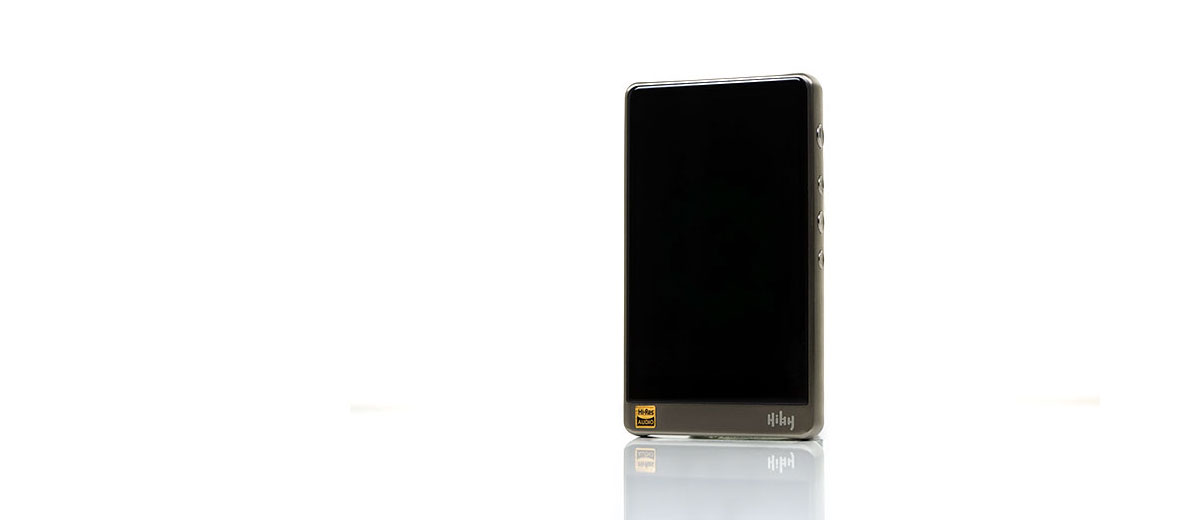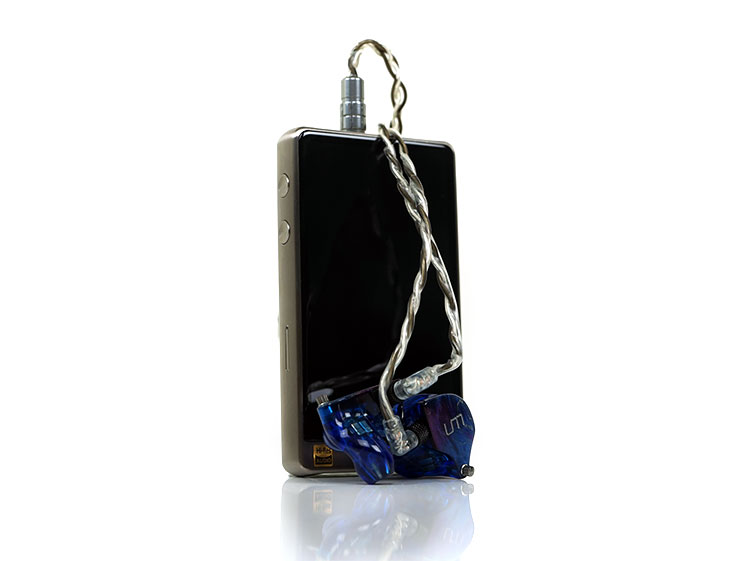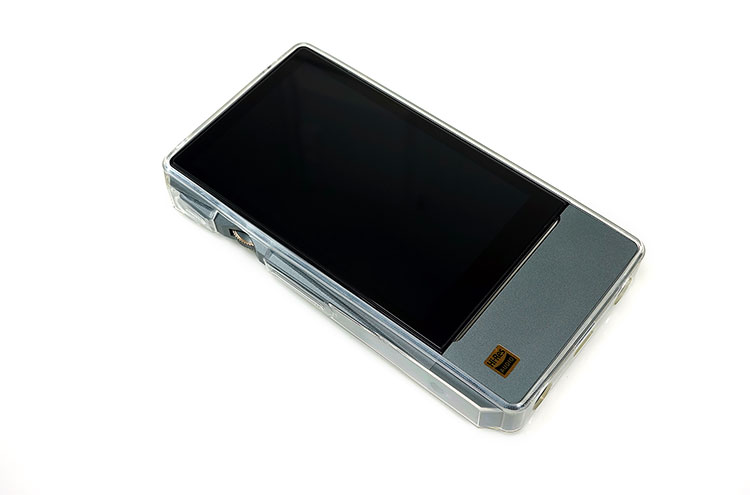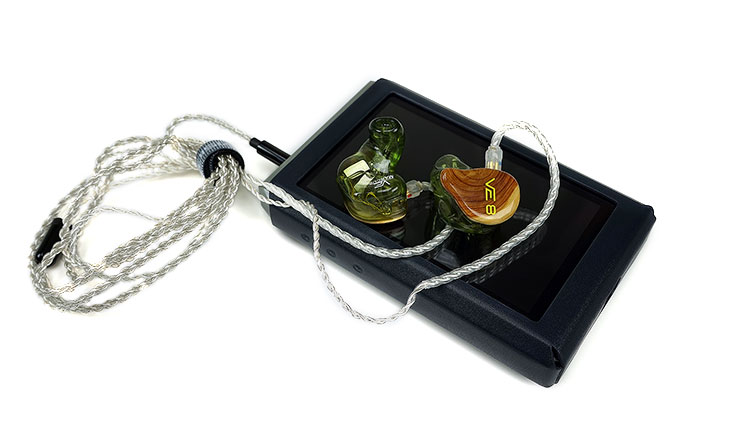Sound Impressions
The Chameleon
The tonality of the R6 is a bit chameleon-like but in a positive way. The TPA6120A amp is a high output impedance amp, as high as 10Ω which means low impedance gear will have an altered response when paired with the R6.
That altered sound may not be consistent either and by that I mean not every low impedance IEM will share the same tonal changes from the R6.
Core Sound
Luckily, we do have relatively neutral Custom Arts FIBAE 1 which uses flat impedance technology that renders the impedance curves change relatively moot. Using this technology I got a fairly good idea of the core sound of the R6.
The R6 delivers a tonality that is fairly beefy and slightly musical in sound with some excellent low-end extension and impact.
If you are coming from the DX200 with AMP 1 then the mids and top-end are in the same ballpark with a refined and slightly thickish note and definitely more body than the X7ii’s cleaner more energetic top end. However, the R6 delivers a bit more bass impact and a slightly more euphonic timbre than the more reference sound of the DX200 (Amp 1).
Staging
The staging on the R6 is impressively wide and deep also. Maybe not quite on par with the airy top-end extension of the Opus#3 but certainly much deeper and more holographic sounding. Sometimes the Opus#3 strikes me as being all about the width and top-end extension whereas the R6 is a little more rounded and natural sounding.
Low-Z Staging
Staging takes a more mids to top end focus with a generally brighter-sounding presentation. Width increases but at the cost of some perceptible depth as the low-end is pulled in a bit more with low impedance headphones such as the Andromeda.
I do find the low-Z R6 staging to have a little more air and sparkle than the core presentation as well as a bit more note articulation and instrumental separation.
Bass
The trump card is the bass delivery of the R6. It is punchy and impactful with an impressive sub-bass presence. For those that think going Sabre means neutral and analytical, we have come a long way from that impression with the R6.
It is not just the power, but the detail also. The low end remains impressively defined and pretty tight. Yes, it’s more elevated and fuller sounding than the DX200’s more linear response but it is able to avoid sounding overly warmed up and muddy sounding also.
Low-Z Bass
The low-end of the R6 is stripped of that impressive fullness and weight though overall I still find it relatively punchy and musical sounding. Certainly a bit lighter but not inherently lean or lacking in extension.
As a result, the low-Z R6 sound doesn’t deliver as much low-end power or depth with a weaker fundamental. Lower pitched instrumental notes become a little more focused on articulation and detail and less about weight and texture.
Mids
Lower mids on the R6 are also positioned slightly further forward and benefit from the low-end fullness with a good instrumental body and a natural to slightly warm timbre lacking in any sharp overtones.
Vocals have a little lift and sound very smooth with little or no sibilance. Female vocals in particular sound beautiful with the R6. There is nothing edgy about this delivery nor is it overly rounded and smoothed over.
Low-Z Mids
The instrumental note body is generally more neutral with the timbre also erring more to the neutral side. As a result, vocals actually have a bit more focus and generally sound a bit cleaner than the stock sound. There are times I actually think that works in the R6’s favor, particularly with some male vocals where I like the spacing and air around them a bit more.
Treble
Treble is full-bodied and natural sounding with good detail and excellent articulation. It is also slightly relaxed, certainly in comparison to the more energetic but slightly thinner sounding X7ii and just a shade behind the DX200 which sounds more neutral in its top-end response.
It doesn’t have quite the same level of sparkle in its top-end as the X7ii electing instead to deliver a very smooth treble response with better weight and a pleasing lower treble percussion timbre. You will not find this DAP to be in any way splashy or brittle sounding for higher-pitched instrumental sound.
Low-Z Treble
Upper mids and lower treble are generally more energetic with a sharper attack and more bite in persuasive timbre. You will definitely hear more cymbal and hi-hat presence with a slightly longer decay and more prominent odd harmonics presence.
Note leading edges will sound a little sharper with a little body sucked out but generally speaking, the R6 lower treble avoids sounding brittle or metallic. Upper treble sparkle also has more presence and energy with slightly more extension and air than the core sound.
Balanced
Going balanced will mean more output power and lower volume requirements. Again, the tonal balance changes slightly for me from the core sound but it is more nuanced than in terms of dynamics and staging rather than the low impedance switch up.
The most noticeable difference is the level of power being generated from the R6 sub-bass presentation. It is more aggressive and physical sounding and reaches that bit deeper than the unbalanced output.
There isn’t an increase in mid-bass warmth for me using the balanced output. If anything the unbalanced has a bit more punch in that area but the level of rumble is reduced by comparison.
Synergy
Efficiency
The R6 output power at 120mW @32 ohms unbalanced and 300mW balanced is actually very good for IEMs and pretty decent for mid-range or portable headphones such as the Meze 99 Classic. It is not groundbreaking though and other DAP amp solutions do deliver more power such as the FiiO AM3, AM3a, and AM5.
Noise
However, in terms of delivering a very low noise floor and black background, the R6 did outperform all of those cards. The DX200 cards are closer in terms of noise performance and I generally regard them as being better engineered with a more nuanced approach to how things should sound.
On efficient IEMs such as the Andromeda, Jupiter, and the Westone W80 there was zero background hiss with the R6. Volume control is smooth with plenty of micro-control in low gain for your IEMs. If you have variable gain levels in your tracks you can always switch on Replay Gain in the settings menu also.
Impedance
The R6 output impedance is 10Ω which is going to be at the heart of some very long debates because it does mean the final sound signature is somewhat ‘fluidic’ depending on what gear you are using.
Low-Impedance
Low-impedance IEMs, particularly those below 20Ω will change in tonal bias. There is less chance of a change the higher up you go so IEMs like the RHA CL1 will sound like they always do. Also, single dynamic IEMs or those not using crossover technology should remain relatively unchanged.
Now, this is not the same as a change in quality. In all tests, the R6 level of detail and performance levels are excellent and unchanging in that respect. However, how much bass, how clean, how rich, how much sparkle?
All those questions become a little ‘up in the air’. If you have a reference sound from your one and only sub-20Ω IEM such as the Andromeda paired with <1-ohm output gear then the R6 is not going to play ball, simple as that.
Staying with the Andromeda, which was the key IEM we used to determine the changes, you will lose a bit of bass weight and fullness though it still stays punchy for me. In return, you will get a cleaner mid-range, a leaner note, forward vocals, and plenty of sparkle in its top-end.
‘Flat’ Impedance
Switching to FIBAE technology (FIBAE 1) or flat impedance technology from Custom Art delivered a more accurate representation of the R6 sound as described above in our impressions. If ever there was a case for buying one of Piotr’s FIBAE creations then the R6 really is it.
I have to remark though, that there are times when I simply preferred the tonal shift and it gave me something I quite enjoyed. The R6 is definitely not like the Shanling M2s in terms of how it stripped the bass right out of the Andromeda.
It still sounded relatively punchy just not as full sounding as it could be. There will be some whom I think will enjoy the brighter, more energetic top-end of the R6 low impedance IEM sound.
Select Comparisons
FiiO X7 Mark II
SRP $649
Technical
I like how FiiO really improved the usability experience of the Mark 2 over the Mark 1 but you are going to notice a considerable lag and lack of smoothness in its response compared to the R6. The numbers do not lie and match my real-world experience. The X7 Mark 2 is the slower device.
The X7 Mark II uses a single ES9028PRO which is the full chip solution as opposed to the 2-channel Q2M mobile version in the R6. The R6, however, uses 2 chips, 1 per channel.
The X7ii’s amp ecosystem really expands the choice and life cycle of the DAP compared to the ‘love it or loathe it’ fixed single amp strategy of the R6. You can change up the sound on the X7 but it will drive up the total cost of ownership compared to the fixed price of the R6.
In terms of power and noise, the FiiO cards vary but the closest in terms of power is the AM2 with the AM3 and AM5 delivering a bit more output power than the R6. Noise and distortion levels on the R6 are noticeably superior to the FiiO amp cards. All my IEMs, even the most efficient ones such as the Andromeda were dead quiet.
The AM3a delivers a bit more power than the R6 but not a huge amount more, around 5-6 steps less on the X7ii in low gain. The AM3a produces a little more noise than the R6 which is very quiet with highly efficient IEMs such as the Andromeda.
Sound
Low Impedance Gear
Whilst it is difficult to clearly establish a base sound with the R6’s 10-ohm output impedance the impact was a little similar to the M2s with efficient IEMs. True enough I did find the low-end of the R6 to be a little cleaner, not as full sounding and the top end a bit brighter but it still sounded satisfyingly punchy.
The X7ii has a slightly greater low-end bias with a warmer and fuller sound but not quite the same level of snap and clarity as to the R6. The R6 is a little more neutral but sounds tighter and better defined.
Mids on the R6 are again slightly cleaner with a bit less warmth but sound a little further forward to me with slightly better dynamic range and control. The staging width on the R6 comes across as a little wider also. You get a slightly softer attack with the X7ii compared to the R6 which in turn delivers a slightly brighter instrumental timbre.
The difference at times is quite nuanced but going back and forward the R6 vocal presence seems further forward, cleaner, and more engaging than the X7ii.
Treble on both was quite interesting to pick out the differences. There is definitely a more forward and energetic lower treble response on the R6 compared to the X7ii. Percussion has more focus and presence on the R6. It is a touch brighter in that respect, however, percussive timbre was a bit more pleasing on the R6. Yes, you will get more snap and bite but it has a bit more body and doesn’t sound as brittle at times.
Normal & High Impedance Gear
Transformational is one way to describe it. The FIBAE range is an excellent base tool to check the 10-ohm output impedance factor and there is a definite change in the presentation of the R6. The low-end immediately sounds more weighted than before and fuller sounding than the X7ii. Note body becomes a lot thicker now with much better texture and generally a more balanced presentation.
The instrumental timbre is a little richer in sound also. It is not bright and breezy as with low impedance gear but it is more solid sounding and makes the X7ii sound a little thin in comparison. Vocal presence is still a little further forward and refined for me but it is not as bright sounding as before. In comparison, the X7ii vocal pitch lacks a little weight and substance.
Perhaps the biggest changeup is the treble performance. On the X7ii you still get plenty of sparkle and just an ever so slightly brittle harder percussion sound. On the R6, however, it is much more refined. A lot of that low impedance “fun” energy has been replaced by a more natural-sounding top end with a better body and a smoother attack.
iBasso DX200
SRP $869
Technical
The DX200 is top of the tree with dual ES9028PRO compared to the R6’s dual ES9028Q2M and the X7’s single ES9028PRO chip design. None of them, as far as I am aware use similar DTA architecture of the R6 so it’s not a given that you will get BIT perfect output on the DX200 and X7ii.
Like the X7 the Dx200 uses a module amp system and it is somewhat more expensive to buy the individual cards than FiiO. However, the amp cards used by iBasso are truly excellent with much lower noise floors and black backgrounds than the Fiio system. Their power ratings vary also but they do pack a punch, especially AMP 1 balanced and AMP 5. The R6’s fixed amp system is equally as quiet thankfully though compared to some iBasso cards not quite as powerful.
The DX200 falls behind really on operational fluidity and that Mango OS is really not up to par. The R6 is much slicker, much faster, prettier to look at, has longer battery life, and generally a more delightful experience in terms of usability.
Sound
The DX200 with its stock AMP 1 card delivers a fairly neutral but smooth and rounded tone from top to bottom. It has a slightly more reference quality to it than the R6 with a more balanced sound.
Low Impedance IEMs
The R6 has a punchier low-end and a bit more energy and presence in its vocal and lower treble delivery. It also has excellent width which is something I noticed also with the X7ii, perhaps superior to both of these DAPs in that regard.
The R6 will come across as the cleaner and brighter of the two and perhaps the more musical of the two also. The DX200 AMP 1 card pulls in the vocals and upper mids/lower treble but adds a bit more body and a more natural flow to its signature.
There is less of a bass/treble contrast with the DX200 AMP 1 card and it will sound perhaps a bit less “exciting” than the R6 which has a bundle of energy from the mids onwards.
Vocals, in particular, show that subtle difference with the DX200 exhibiting a slightly softer and smoother attack compared to the sprightlier and more contrasting vocal timbre of the R6.
Normal to high Impedance
With flat impedance or higher impedance gear such as the FIBAE 1, the R6 sounds a lot closer to that refined DX200 sound with just a few minor differences (AMP 1 card). The first is the slightly weightier low-end of the R6.
The AMP 1 card of the DX200 is the more linear and correct of the two in terms of bass response with a slightly better balance. This is closer to AMP 2 in tonal bias.
People will still find the R6 the more musical of the two but the gap is much more nuanced now than with lower impedance IEMs. Part of that is due to the much smoother mids and the top end of the R6.
The instrumental timbre is also a tiny bit thicker sounding than the DX200 AMP 1 with that heavier bass signature injecting a bit more body into lower mid-pitched instruments.
One thing I did note is the mids and vocals presence of the R6 are a little further forward than the more neutral positioning of the DX200. I also found the R6 to have a little more top-end body as well as a more relaxed treble presentation than the DX200 treble response.
Summary
The DX200 is more refined, perhaps the more reference or accurate of the two, especially with low-impedance gear. The R6’s low-impedance energetic presentation will deliver a bit more pop and musicality and generally will come across as the more immediately engaging of the two.
It gets a lot closer with FIBAE delivering a much more refined and controlled sound. However that bassier low-end of the R6 tips it more to the musical side.
Opus#3
SRP $899
Technical
I understand why The Bit walled off the Opus#3 Android experience and skinned it to make it more simplistic. It is stable, fast enough and focused purely on audio. In many respects that was the goal of Opus#3. Yes, you can sideload and the list of apps people have tried is good but it is not an open experience, not by any means.
Lined up against the R6 in terms of an open fast Android experience there is a night and day difference between the two. No competition.
You are talking about 5.1 versus 6.01, 1Gb RAM versus 3GB of RAM, and an ARM Cortex-A9 1.4GHz in the Opus#3 versus a Snapdragon 425 in the R6. I suspect if the BIT let the Opus#3 out of the walled garden completely it would be a lot slower.
DAC
Opus#3 uses a single Burr-Brown PCM1792A compared to the dual Es9028Q2M design of the R6. The chip inside the Opus#3 is an ‘oldie but a goody’ though I think it lacks the clarity and punchiness of the R6 (see sound impressions below).
Amp
The amp system in the Opus#3 is also fixed just like the R6 and both are actually very good indeed in terms of delivering a clean low distortion hiss-free sound. On paper, the R6 has the superior SNR and THD-N numbers for its TPA6120A by around 5dB and 0.0001%.
The killer omission for me on Opus#3 is the lack of a dedicated line out. This is not a true line out, it does go through the Opus#3′ own amp so that is a bummer for me.
Sound
Low Impedance Gear
Opus#3 has a warm and relaxed tonal presentation. The R6 is more dynamic and cleaner sounding.
Both sound pretty open with good headroom and excellent width but the Opus#3 is perhaps a bit too linear in its delivery leaving me wanting a bit more pop. It is easy going but at times I find it too easygoing and flat sounding compared to the punchier R6.
You could say the Opus#3 sounds incredibly rounded with a very even harmonic emphasis in its instrumental timbre and a soft smooth vocal delivery. The R6, however, balances that out with a better even/odd harmonic balance that adds a bit more snap and bite to instrumental timbre and a cleaner more accurate vocal presence.
Normal and High Impedance Gear
With FIBAE 1 the R6 becomes a lot smoother and not quite as bright sounding in comparison to the Opus#3. The additional low-end weight and fullness of the R6 are really the difference maker here. The Opus#3 bass response, whilst retaining a healthy degree of warmth, doesn’t sound as punchy and powerful as the R6 low-end. In fact, it is a lot politer in comparison.
Conversely, the mids and top-end of Opus#3 sound a little more open now and spacious. The instrumental timbre is thicker sounding on the R6 by comparison with the Opus#3 a bit more neutral in comparison.
Treble on the Opus#3 is a touch more neutral in positioning and a little airier sounding than the R6 this time around. The R6 gains a bit of body for a more natural treble sound but it also gets a bit more relaxed than with low-impedance IEMs.
Our Verdict
Value
The R6 is a truly excellent digital media player with an insane price for the features and hardware inside. I have been saying this all year and the R6 really caps off what I think is a stellar year for getting the price to performance ratio just right in the sub-$1000 category.
As IEMs and headphones continually challenge us in terms of value the DAP market has taken up the cudgels and there is no finer example than the R6 right now. I spoke highly of the DX200 in terms of its price point and what it offers and I think in some ways the R6 offers a lot more.
The only downside is I can’t tell you what more it can offer until that international firmware is out. As it stands HiBY Link, aptX, and USB-DAC features, as well as Google Play, are not available. They will be though in a few weeks’ time so I look forward to trying that out. Note below we do have that new firmware list of features for your reference.
HiBy R6 Technical Specifications
Click here to see specifications in full detail.









